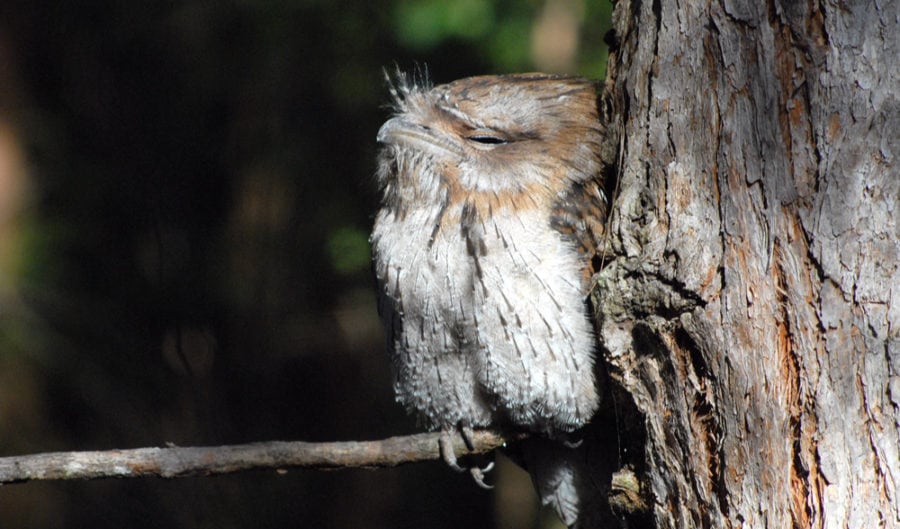Urban birdwatching guide to Adelaide
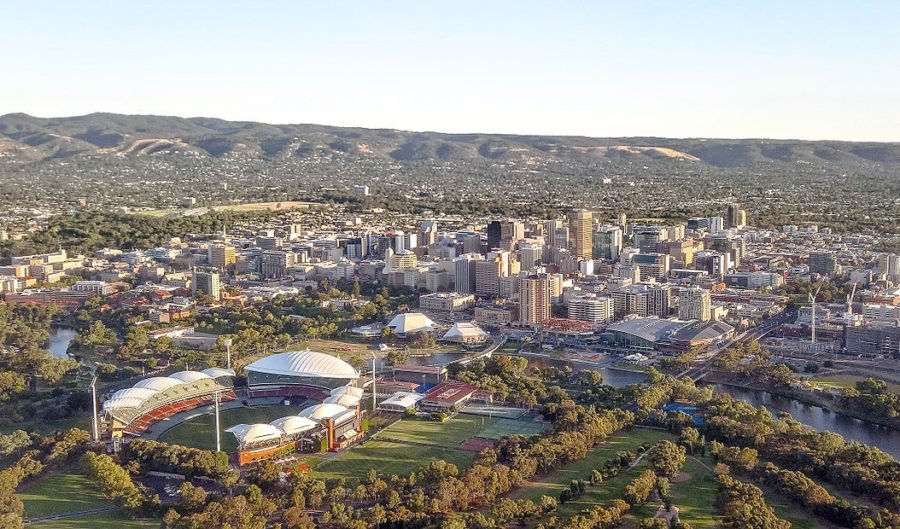
According to Birds SA president John Gitsham, keen birders could rack up 50 or 60 species in just a few hours.
Within the city, a stroll along the River Torrens to the Adelaide Botanic Gardens allows for plenty of birdwatching opportunities, from rainbow lorikeets on the “Drunken Parrot Tree” to cheeky noisy miners.
Just 30 minutes north of the city, a series of tidal flats forms the Adelaide International Bird Sanctuary. “Along the shoreline, you get up to 37 different migratory species of shorebirds, which fly down from the northern hemisphere,” says John. The area is home to other avian attractions too: “At Whites Road, you get the white-winged fairy-wren, a desert species you can find within 15 minutes from Adelaide.”
For woodland birdwatching, Browns Road, Monarto, is the place to be. “You can spot 40-odd species, including four or five endangered species,” says John, “Things like restless flycatchers, diamond firetails and in the summer, rainbow bee-eaters.”
The wetlands dotted around Adelaide are a treasure trove for birdwatchers and photographers. “Laratinga Wetland is very popular and accessible,” says John. “You could see up to 70 species, including rare species like freckled ducks, Latham’s snipe and various crakes and rails.” Other wetlands of note include Tolderol Wetland, home to thousands of waders, and Paiwalla Wetland near Murray Bridge, where you can observe eight raptor species.
“You can go birdwatching anywhere,” says John, “But to try and find specific birds, speak to Birds SA and we’ll point you in the right direction.”
Whet your birdwatching appetite with these 20 Adelaide-dwelling species.
1. White-winged fairy-wren
Malurus leucopterus

(Image Credit: David Cook/Flickr (CC BY-NC 2.0))
Most of the time, these feather-spheres appear sandy-brown with bluish tailfeathers. But come breeding season, the males transform into electric blue attention-seekers.
In a courtship display, he will bow to a female, flattening his feathers to the horizontal. A white band, formed by their wingfeathers, accentuates his striking blue plumage. Females will respond by performing a wing-fluttering dance: she will lower her head and tail, then outstretch her wings and flutter them with an open beak.
Nests are hidden close to the ground, so be careful you don’t trample any on your quest to see these azure pom-poms!
Size: 13cm
Call: high-pitched, three to five chirps followed by series of rising and falling notes
Where to spot them: Whites Road, Adelaide International Bird Sanctuary
2. Freckled duck
Stictonetta naevosa

(Image Credit: Ed Dunens/Flickr (CC BY 2.0))
You can see Australia’s rarest waterfowl at Laratinga Wetland. Freckled ducks have dark brown plumage flecked with white. Their bill is slate grey and slightly upturned – but in breeding season, the male’s bill will be tinged with fire engine red.
Freckled ducks prefer well-vegetated freshwater swamps, but also inhabit lakes, wetlands and sewage ponds. Alternative names include the oatmeal duck – because apparently their plumage looks like oatmeal – and the monkey duck – an enigmatic name, the origin of which has been lost.
Size: 54cm
Call: soft piping, melodious ‘wheeeooo’
Where to spot them: Laratinga Wetland
3. Purple-crowned lorikeet
Glossopsitta porphyrocephala

(Image Credit: Dave Curtis/Flickr (CC BY-NC-ND 2.0))
If you’re near flowering eucalypts and you hear noisy chattering, crane your head to the canopy and you may spot a purple-crowned lorikeet amongst a noisy flock of honeyeaters and other lorikeets. These small green parrots are named for the patch of royal purple adorning their head. Their colourful garb also features an orange-red patch above the beak, orange cheek patches, crimson underwings, a powder-blue tum and yellow undertail.
These tiny parrot-jewels are most easily recognised by their high-pitched screeching (which gives them their alternative name, the zit parrot).
Size: 15cm
Call: Short, sharp ‘zit-zit-zit’; chattering when feeding
Where to spot them: Woodlands, mallee, parks and gardens of suburbs
4. Restless flycatcher
Myiagra inquieta

(Image Credit: Patrick Kavanagh/Flickr (CC BY 2.0))
As its name suggests, restless flycatchers spend a lot of time busily pecking insect-snacks off the mid-canopy. To do this, they hover. While hovering, restless flycatchers emit a continuous whirring hissing – a call that has earned them names including “razor grinder”, “scissors grinder”, and “dishwasher”.
Restless flycatchers have similar colouring to willie wagtails, but it’s easy to tell them apart. Flycatchers are slimmer, and lack the wagging fan tail and angry white eyebrows of willie wagtails. Restless flycatchers have a small glossy dark blue crest, grey-blue upperparts and white underparts.
Size: 20cm
Call: rasping, hissing
Where to spot them: woodland, farmland, Browns Road-Monarto
5. Rainbow bee-eater
Merops ornatus
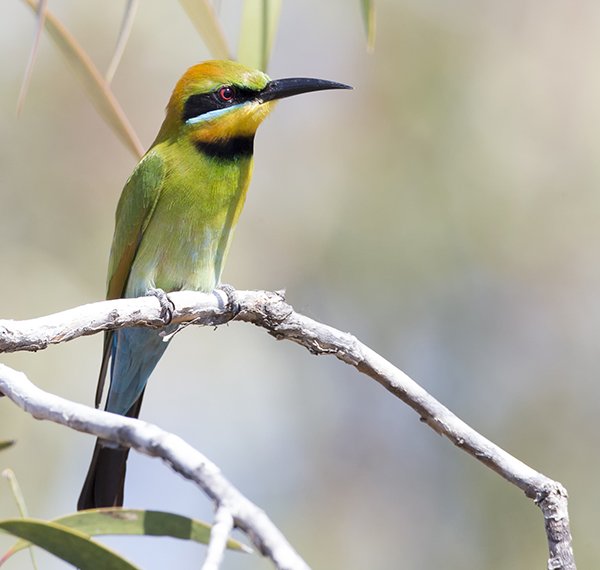
(Image Credit: Jim Bendon/Flickr (CC BY-SA 2.0))
With striking colouring, rainbow bee-eaters are some of the most spectacular birds you’ll encounter during summer in Adelaide’s woodlands. Often spotted perched on a powerline or fence post, rainbow bee-eaters catch their insect prey on the wing. They have a preference for bees and wasps, and after catching them, will return to their perch and rub the stinger and venom sacs off. They can chow down on several hundred bees per day!
Rainbow bee-eaters mate for life, and dig a burrow in the ground to nest in. During winter, they’ll migrate to northern Australia and New Guinea.
Size: 19–24cm
Call: high-pitched chitter
Where to spot them: woodland, Browns Road-Monarto
6. Diamond firetail
Stagonopleura guttata

(Image Credit: David Cook/Flickr (CC BY-NC 2.0))
Catching a glimpse of the striking diamond firetail is sure to delight any bird enthusiast. These little finches are light grey on top, with tan-coloured upper wings. These muted tones are offset by a thick black neck band, black eye stripe, black tail and black lower wings with bright white spots. Their belly and chin are white, while their bill, eyes and rump are fiery red.
These tiny gems feed on seeds on the ground. To woo a female, a male will brandish grass in his beak, and bob up and down while singing in his husky voice. To protect their precious offspring, the pair will build a nest amongst thick prickly shrubs, or they may even build it into the base of a large stick nest belonging to a bird of prey!
Size: 12cm – slightly smaller than a house sparrow
Call: mournful double whistle
Where to spot them: woodland, grassland, mallee, Browns Road/Monarto
7. Australian owlet-nightjar
Aegotheles cristatus

(Image Credit: Richard Crook/Flickr (CC BY-NC-ND 2.0))
The smallest of Australia’s nocturnal birds, owlet-nightjars are mysterious and only about the size of a noisy miner. They are grey in colour, with pale underparts faintly barred with black. Two wide, dark stripes extend from their eyes over the top of their head. Owlet-nightjars can be tricky to spot, as their eyes are not reflective like other nocturnal birds, but listen out for their chirring call at night.
Owlet-nightjars form permanent pair bonds, and together couples will establish a territory in which to hunt insects.
Size: 23cm
Call: loud grating chirr – two or three notes
Where to spot them: open woodland with plenty of hollows, Browns Road/Monarto
8. Mount Lofty Ranges southern emu-wren
Stipiturus malachurus intermedius
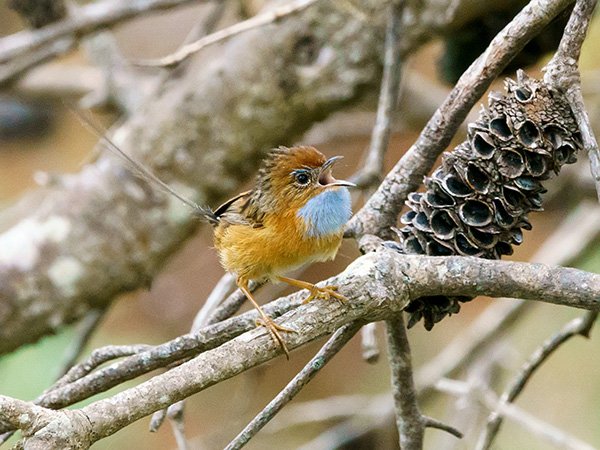
(Image Credit: David Cook/Flickr (CC BY-NC 2.0))
Picture this: a tiny feathered ball with a series of six wispy tailfeathers twice its body length. That’s what a southern emu-wren looks like. In the Mount Lofty Ranges, south of Adelaide, a unique subspecies inhabits the densely-vegetated marshes. The secretive Mount Lofty Ranges southern emu-wren is endangered, with a total population less than 500 individuals.
Males have chestnut-red plumage streaked with black, a vibrant rust-coloured crown, sky-blue throat, chest and eyebrow, and grey-brown wings. Females are streaked with darker hues, and lack the male’s fetching crown and blue accents.
Southern emu-wrens are very shy and don’t fly very well, instead preferring to scamper like a mouse in thick cover.
Size: 20cm (including tail length)
Call: soft high-pitched trills and buzzes; similar to fairy-wrens
Where to spot them: Mount Compass, swamps in the Mount Lofty Ranges
9. Eastern curlew
Numenius madagascariensis
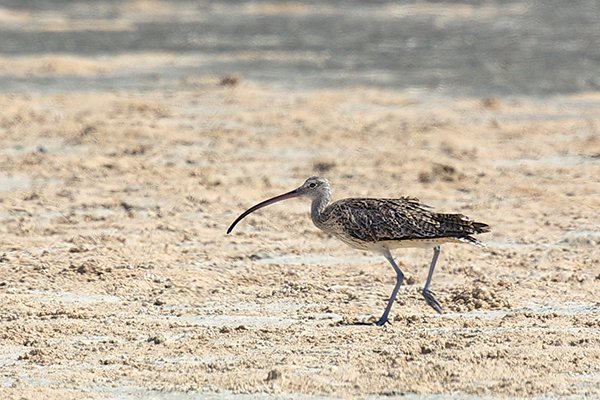
(Image Credit: Julie Burgher/Flickr (CC BY-NC 2.0))
Like most shorebirds, eastern curlews lack a gaudy get-up, instead opting for streaked brown-and-buff plumage. With long legs and long curved beak, eastern curlews are perfectly proportioned for stalking through the shallow intertidal mudflats, probing for tasty crabs and molluscs. They are the biggest wader species to visit our shores.
Every year, eastern curlews migrate from their breeding grounds in Russia and north-east China to soak up the sun in the southern hemisphere summer. They are one of several species to utilise the East Asian-Australasian Flyway, a migratory route spanning 22 countries. Over its lifetime, an eastern curlew may fly a cumulative total equivalent to the distance from the Earth to the moon.
Size: 63cm
Call: mournful cuuur-leee, rising in pitch
Where to spot them: Adelaide International Bird Sanctuary, intertidal mudflats
10. Latham’s snipe
Gallinago hardwickii

(Image Credit: Ed Dunens/Flickr (CC BY 2.0))
Latham’s snipe also utilises the East Asian-Australasian Flyway, arriving in Australia in September after a long flight from breeding grounds in Japan. These shy waders inhabit freshwater wetlands. They have a long straight bill, short-ish legs and eyes set well back on their rounded head. Their mottled brown and white plumage provides the perfect camo for blending in, so they can be tricky to spot. Your first sighting might be of a blur of feathers fleeing in zig-zag flight, accompanied by harsh ‘crek’-ing.
In Japan, Latham’s snipes are called “thunder birds” due to the drumming sound their tailfeathers make when performing an elaborate mating display flight.
Size: 31cm
Call: ‘crek’
Where to spot them: Laratinga Wetland, shallow freshwater wetlands with vegetation
11. Hooded plover
Thinornis cucullatus
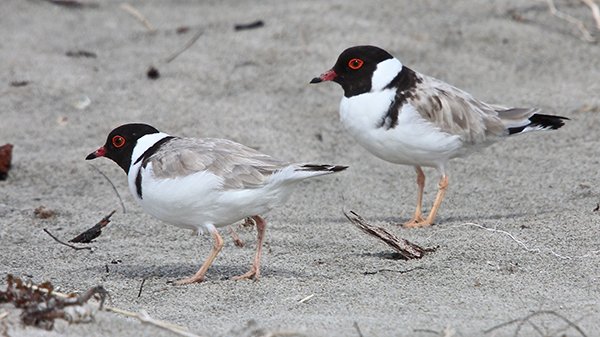
(Image Credit: Matt Francey/Flickr (CC BY-NC 2.0))
Hooded plovers, or “hoodies”, are stocky little shorebirds. They have sand-coloured plumage, a black “hood” and collar, a white nape and white underparts. These neutral tones are offset by pink legs, and an orange-red bill and eye ring. You can spot hoodies darting along the seashore, snapping up sandhoppers and other invertebrates. They inhabit sandy beaches with ocean swell – the same beaches us humans like to frequent. Hoodies are endangered, in part because of human disturbance.
Hoodies lay their eggs in a shallow scrape of sand on the upper beach or amongst sand dunes. But if they are persistently disturbed, hoodie parents will abandon their nest. There are less than 800 individuals in South Australia, but in the past year a pair have nested at Seacliff beach. If you spot a loved-up plover pair, enjoy the sight but keep quiet and keep your distance.
Size: 21cm
Call: short piping
Where to spot them: sandy beaches, sand dunes
12. Red-necked stint
Calidris ruficollis

(Image Credit: Ed Dunens/Flickr (CC BY 2.0))
These tiny migration-marathoners are about the size of a house sparrow, and weigh as little as a single tim-tam. Each year, they breed in the Siberian tundra, before embarking on an epic journey south to Australia along the East Asian-Australasian Flyway. While in Australia, their plumage is a mixture of white underparts, a sandy head and mottled grey-brown upperparts. With their stumpy legs and hunched posture, they congregate in dense flocks, darting across intertidal mudflats and foraging with quick pecks.
Size: small, plump, about the size of a house sparrow
Call: high-pitched ‘chit’
Where to spot them: sheltered inlets, bays, lagoons and estuaries; Adelaide International Bird Sanctuary
13. Peregrine falcon
Falco peregrinus

(Image Credit: Paul Balfe/Flickr (CC BY 2.0))
The peregrine falcon is a bird of superlatives: it is the most widespread bird of prey in the world, and also the fastest animal in the world. During its impressive hunting high-speed dives, it can reach speeds of 320km/h. The highest recorded speed is 389km/h.
These medium-sized birds have a black head, slate-grey back and wings, creamy chest and buff underparts barred with black. Peregrine falcons sport a long, narrow tail rounded at the end, and can be identified in flight by their curved trailing wing edge.
Size: 43cm
Call: loud, shrill ‘kek-kek-kek’
Where to spot them: Paiwalla Wetland
14. Crimson rosella
Platycercus elegans

(Image Credit: Alan & Flora Botting/Flickr (CC BY-SA 2.0))
The crimson rosella is a vibrant visitor to Adelaide gardens. Throughout Australia there are multiple colour morphs of this rosella species, and here you’ll find the unique-to-Adelaide form, displaying varying shades of orange. The orange-y Adelaide rosella is the result of interbreeding between yellow and crimson variants.
Look out for rosellas chattering and whistling in small flocks as they forage for seeds and berries. They will readily visit backyard bird feeders and after familiarisation, some will accept handheld tidbits.
Size: 34cm – but most of that length is the long tail!
Call: metallic ‘klee-klee’, melodious whistling and chattering
Where to spot them: backyards with trees, forests
15. Noisy miner
Manorina melanocephala

(Image Credit: KR Adventures/Flickr (CC BY-NC 2.0))
These small birds are feisty, and they certainly live up to their ‘noisy’ moniker. Grey-feathered with a black face and a yellow bill, noisy miners can be found in suburban gardens and parks. As part of the honeyeater family, they eat nectar, fruit and insects, usually in a rowdy group.
Noisy miners are aggressive, often attacking much bigger birds such as hawks. They’re also curious: some have been recorded opening sugar packets at cafés in search of a sweet snack.
Size: 26cm
Call: Loud piping ‘pee-pee-pee’
Where to spot them: Woodland, urban parks and gardens
16. Rainbow lorikeet
Trichoglossus moluccanus

(Image Credit: David Midgley/Flickr (CC BY-NC-ND 2.0))
Rainbow lorikeets are hard to miss with their brightly-coloured garb and noisy chattering. They fly super-fast in tight squadrons and prefer the leafy surrounds of tree-filled suburbs, especially if plenty of tasty nectar or fruit is available. Rainbow lorikeets roost communally, so you can often hear them squabbling and telling cacophonous bedtime stories around sunset. These clowns have a blue head and tum, green back and wings, bright orange breast and red beak.
In late spring and early summer, rainbow lorikeets flock to a certain tree next to the Summer House in the Botanic Gardens. Here, they imbibe its fermenting nectar, becoming intoxicated in a raucous drunk-parrot-party.
Size: 30cm.
Call: Screeching, chattering.
Where to spot them: Suburbs and parks with tall trees, forests, around flowering or fruiting plants.
17. Royal spoonbill
Platalea regia

(Image Credit: Geoff Whalan/Flickr (CC BY-NC-ND 2.0))
Spoonies are unmistakable with their snow-white plumage, long dark legs and spoon-shaped bill. You can spot them wading through the shallows, sweeping their bill in wide arcs through the water. When vibration sensors inside their bill detect a tasty fish or shrimp, they will snap their bill shut like a pair of tongs.
In the breeding season, spoonies flaunt a headdress of white plumes befitting their royal moniker. They will raise this crest during breeding displays to reveal pink hues beneath. A vibrant pink strip is also visible under their wings during flight. The spoonbill’s face is black with yellow eyeshadow and a red patch on their forehead.
Size: tall and leggy – 78cm
Call: soft grunts and honks, bill-snapping and “wing-woofing”
Where to spot them: wetlands, intertidal mudflats, Adelaide International Bird Sanctuary
18. Australasian shoveler
Anas rhynchotis

(Image Credit: Sascha Wenninger/Flickr (CC BY-SA 2.0))
Australasian shovelers were once called “stinkers” thanks to their unpalatable taste.
Inhabiting well-vegetated swamps, these low-floating ducks have a distinctive shovel-shaped bill. It is adapted for filter feeding, with special grooves along the edges to filter plant matter, crustaceans and insects. When dabbling (tipped upside down to feed underwater), you can see their orange feet.
Females are mottled brown above and chestnut below, while males have a black back and rump, blue-grey wings and chestnut underparts. Males’ breeding plumage features a blue-grey head with a white crescent in front of each eye.
Size: 50cm
Call: usually silent, male sometimes ‘toots’ softly, females sometimes quack. Whirring noise in flight.
Where to spot them: swamps, Laratinga Wetland
19. Crested pigeon
Ocyphaps lophotes

(Image Credit: James Niland/Flickr (CC BY 2.0))
Once restricted to the inland arid regions of Australia, crested pigeons have found a new niche in Australia’s cities. These punk pigeons are easily identified by their spiky black crest. They have a grey face and underparts melding into sandy brown upperparts. The wings are striped with black and feature metallic patches of purple and green.
When crested pigeons flap their wings, a noisy whistle is produced due to air rushing over a specially modified feather. Upon landing, they will flick their tails up.
To attract a female, male crested pigeons perform a pigeon version of moshing. They bob their plump bodies up and down, fanning out their tail and wings and making soft hoots.
Size: 30cm
Call: soft hooting, but you’re more likely to hear the whistle (like a wind-up toy) of their wings
Where to spot them: parks, sports fields, open lawns, farmland
20. New Holland honeyeater
Phylidonyris novaehollandiae

(Image Credit: Davis Kwan/Flickr (CC BY-NC 2.0))
New Holland honeyeaters came in second place as the most-commonly counted bird in South Australia during 2017’s Backyard Bird Count. Look for these inquisitive birds busily feeding on nectar in grevilleas and banksias. New Holland honeyeaters are very active and rarely sit still. But when they pause, you’ll catch a glimpse of a black face with white tufts and white eyes, a black and white streaked belly, and yellow streaked along tail and wings.
Size: 18cm
Call: chattering, loud ‘chik’, faint ‘pseet’
Where to spot them: woodlands, gardens
